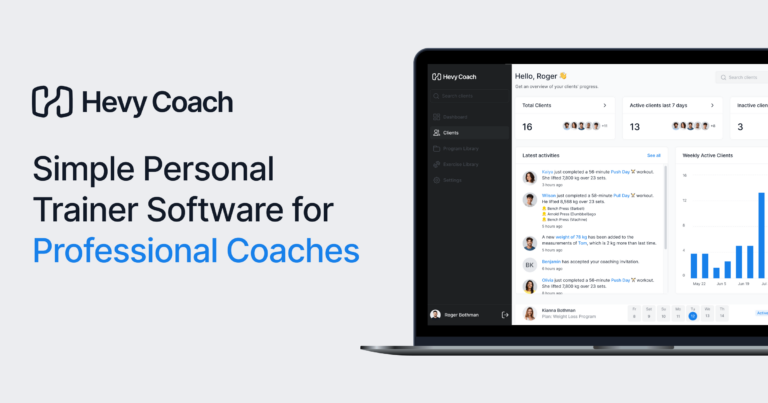Struggling to find new clients is one of the most frustrating experiences for personal trainers.
You know how valuable your services can be, and you’re motivated to help people lead better lives, but you can’t sign anyone. Even when someone decides to work with you, it’s only for a short while before they quit.
But how do you rise above the noise and get people to notice you, especially if you’re new? The short answer is to leverage several effective tactics, gain exposure, and work on your reputation. From there, employ additional tactics to leverage your existing business to attract new clients.
Read our guide to learn everything there is to know on the topic.
Understanding Your Target Market
Setting up a successful personal training practice starts with understanding your target market.
One of the biggest reasons businesses often fail is that they don’t take the time to understand who they are trying to serve. As a result, they cannot develop good products, establish clear parameters for their services, or put together a marketing plan to attract the right people.
Here are some crucial steps to take:

Try Hevy Coach
Intuitive personal trainer software, with a world class experience for your clients.
30 day free trial, no credit card required
Step 1: Identify Your Niche and Speciality
A wise man once said, “If you try to please everyone, you’ll please no one.”
It can be tempting to market yourself as a jack of all trades––someone who can help every person, regardless of the situation. Unfortunately, that’s not how the world works.
Even if you have the knowledge and experience to help many people, trying to market your services to everyone will leave you with a vague or convoluted message that confuses prospective clients.
A better approach is to identify your unique niche and specialty. Focusing on a specific group will allow you to narrow down your efforts. You can create a more detailed marketing message and produce the right content to build an audience.
For example, you can niche down and work with elderly clients. Older adults have the resources and time for fitness, and most of their friends are in the same age group. One happy client can bring five or even ten new ones.
Other niche ideas include pregnant women and obese individuals.
Another benefit of choosing a niche is that you gain more expertise and become more capable of helping people in a specific situation. For example, by exclusively working with people with obesity, you learn about their most common struggles and can coach them more effectively.
Step 2: Define Your Ideal Client
Defining your ideal client can be as simple as imagining who that person is and what goals they want to achieve or as complex as making a customer avatar.
Regardless of your approach, it’s best to sit down and imagine what the perfect client would be. Consider things like:
- Who is that person?
- Where do they hang out online?
- What challenges are they facing?
- What goals would they like to achieve?
- What is stopping them from getting results?
- How can you help them?
Step 3: Conduct Market Research
The next step in the process is to examine what type of potential clients are out there to determine if you’ve selected a good niche and if your ideal client exists.
The first place to look is your local gym. Identify different groups of people and try to understand their struggles––big and small. Maybe they feel self-conscious and mostly stick to the familiar treadmill. Or perhaps they don’t know how to use gym machines, aren’t sure what load to select, or exercise with poor form.
Even the smallest details can be helpful and provide you with talking points for your marketing material and sales pitch.
Additionally, research other personal trainers online to see what clients they have, how they conduct themselves, and how they approach marketing. You shouldn’t copy others, but there is nothing wrong with taking inspiration.
Online forums can also be a great place to learn about your potential clients’ struggles, frustrations, and limiting beliefs. Notice the language people use and experiment when writing your marketing copy.
Step 4: Set Realistic Client Acquisition Goals
Every trainer aspires to get personal training clients fast, but you must be realistic, especially early on. Even if you have an audience and a newsletter (more on that below), getting people to pay for your coaching services is a difficult and frustrating experience.
You can’t start now and sign twenty clients in a month. A better goal is to sign three people in the first few weeks and gradually expand your roster. Below, we’ll go over specific tips on leveraging existing clients to get more business.
Building a Strong Personal Brand
Understanding your target market is the first crucial step you need to take. It won’t necessarily make you money, but it will set you up for success.
Now is the time to start working on your brand. Doing so lets prospective clients know you exist, educates them for free, and helps you develop relationships.
1. Create Your Website

Some might argue that a website is unnecessary and that your efforts should go toward social media.
We agree that Instagram, TikTok, and similar platforms can be good places to engage with people and promote your personal training services. Still, there is an argument to be made about owning a website.
For one, the site is yours, and you’re not at the mercy of a social media algorithm that favors you today but kills your reach tomorrow.
Second, a website allows you to collect all the relevant information about you and your services in one place for prospective clients.
Third, you can include a blog section on your website and share helpful content for free––blog entries, articles, how-to guides, and videos. Doing so is a great way to build a presence, help people, and display your expertise.
Of course, your website doesn’t have to be complex at first. Start with:
- An about page that includes your bio and some relevant info; add one or two high-quality, relevant photos of yourself
- A landing page that describes your services, packages, and other relevant info
- A contact page that lists all the ways prospective clients can reach you
2. Build an Email List
An email list is a collection of email addresses people have shared with you, typically in exchange for something. For example, you can set up an opt-in form on your site and ask visitors for their email in exchange for a goodie:
- A short PDF
- An email series
- A template of some kind
Once on your list, you can provide even more value to your subscribers through additional PDFs, training recommendations, weekly tips, a newsletter, or something else. Occasionally, you can mention your personal training services and encourage those interested to reach out.
Aweber, MailChimp, and ActiveCampaign are three popular brands that store your email list on their server. As a result, you can segment your subscribers into different lists (e.g., based on interests) and email everyone in just a few clicks.
Building your email list from day one is incredibly valuable because these people tend to be more engaged. Providing some value consistently builds your reputation and makes these people even more interested in what you have to say.
Even if you don’t get personal training clients fast, an engaged email list could result in tons of new business down the road.
Check out: 7 Experts on Why Building Your Email List Is So Important
3. Leverage Social Media
As briefly mentioned above, platforms like TikTok and Instagram can be great for gaining popularity in the health and fitness industry.
You can create profiles on these websites and start sharing helpful information that could benefit your target audience. You can also promote your website there and encourage those interested to learn more about you.
One distinct advantage of social media sites, especially TikTok, is that there is a virality element. Some helpful and unique information you share could receive a lot of exposure, grow your followers’ list, and help you land some clients.

Social media is also fantastic for engaging with people, answering questions, and building your reputation further. Becoming the go-to person for people in need of fitness information is an excellent way to grow your personal training business.
Be on the lookout for our complete social media promotion guide in the upcoming months.
Before Moving On
Building a solid personal brand and landing training clients takes time. One of the most important things to remember is to look professional.
For example, when setting up your website, spend money on a professional theme or pay a designer to do it for you. Similarly, get some good photos of yourself to upload across social media and on some of your website pages.
You could be a fantastic personal trainer, but how you present yourself can make or break your business. Be objective and consider the first impression you would leave on people running into your social media profiles or website for the first time.

Try Hevy Coach
Intuitive personal trainer software, with a world class experience for your clients.
30 day free trial, no credit card required
Networking and Referrals
Networking with other fitness professionals and leveraging referrals are fantastic ways to grow your presence further and get more personal training clients.
1. Networking
Networking is crucial for personal trainers to develop professional connections, increase their presence, and sign more personal training clients. However, doing so can be easier said than done.
Creating a professional-looking website and social media profiles makes networking with peers easier. Here are some suggestions:
- Website content production – reach out to personal trainers to ask for a quote or opinion on a matter and include that in your blogs/articles
- Social media content – reach out to other professionals and set up collaborations, where you meet up and do something together
- Social media connections – chat with other professionals and exchange ideas and tips
You can also join forums and social media groups where other professionals get together to share ideas, ask for advice, etc.
Of course, networking doesn’t have to be limited to the online world. There are plenty of other ways to connect with professionals and prospective clients. For instance, you can associate with coaches, trainers, and physiotherapists in your local area.
Conferences and fitness events provide even more promising opportunities to meet professionals, form relationships, swap ideas, and get your name out there.
2. Establish Local Partnerships
One common way to establish local partnerships is to leverage your resume and connect with the owner or manager of a local training facility. That would allow you to lead group classes or coach people one-on-one and earn a commission.
While that might not always be the most lucrative approach, it provides access to an established client base, allowing you to build a reputation in your area. For example, leading a group fitness class would give you access to dozens of people eager to get fit.
One major disadvantage of a group setting is that you cannot provide as much personalized guidance to everyone, especially if you’re working with ten or more people simultaneously. So, those interested can take advantage of your personal training services.

Even if you don’t earn much, providing personal training services could help you land some of your first clients. You can then ask some of these people for testimonials (more on that below) as social proof for signing up new clients.
Try Hevy Coach today if you’re looking for a simple platform that allows you to manage all of your personal training clients.
3. Be Helpful
Everyone in need of help could benefit from your guidance. Being a helpful person without expecting anything in return could get you far.
For instance, let’s say that you spot someone who struggles to navigate the gym, doesn’t know how to use machines, and lacks experience. Approach them and offer some help, but be mindful of their body language and be ready to walk away if they feel too self-conscious.
There are different opinions on approaching people to help. Some folks are against that, whereas others encourage it. We think it’s best to read each situation carefully and help only if the person is ready to receive guidance.
A person at the gym might decline your offer initially, but they could eventually work up the courage to ask for help. If not, at least you tried.
On the note of helping people, do so without expecting anything in return. Don’t immediately introduce yourself as a trainer or ask if they need personal training services. People don’t like being sold to, especially at the gym.
Plus, introducing yourself as a coach could make them feel even more self-conscious because they lack the experience and knowledge to navigate a training facility. Be friendly, smile, ask if they need help, and maintain your distance.
4. Join Professional Organizations
Joining professional organizations doesn’t exactly fall within the ‘Networking & Referrals’ category, but it is still a great way to:
- Connect with fitness and health professionals
- Expand your knowledge and expertise
- Gain access to a monthly journal
- Learn about upcoming events and get member discounts
Some popular organizations to consider include:
- American Council on Exercise (ACE)
- Collegiate Strength & Conditioning Coaches Association (CSCCa)
- National Council on Strength & Fitness (NCSF)
- American College of Sports Medicine (ACSM)
Each will have unique requirements, so it’s best to research before applying. For instance, here is what the American College of Sports Medicine requires:
“Professional membership is open to anyone who has earned a bachelor’s, master’s or doctoral degree at an accredited institution in a field related to health, physical education or exercise science; or, anyone who has earned at least a bachelor’s degree in another area, but is working in a field related to sports medicine or exercise science.”
You can learn more about the application process and the benefits of joining here.
Offering Free Trials and Promotions
Signing personal training clients can be a long and difficult process unless you get a lucky break early on and establish yourself. Some personal trainers need weeks or months to sign their first client.
Here are some simple tactics you could use to get more personal training clients:
1. Offer a Free Trial Session
Offering free trial sessions is the least desirable option for most trainers but, ironically, one of the best ways to get personal training clients. People are reluctant to give money to new coaches, but most will be willing to give you a chance if it costs them nothing but time and effort.
The primary issue is that you would have to do an initial consultation and a personal trainer assessment to ensure you would be a good fit. Add a 45-minute training session on top of that, and you’re looking at a solid two hours of work without earning money.
The upside is that some of these people will decide to give you a chance afterward, but don’t expect a 100 percent conversion rate. You would be lucky to sign one in five people.
2. Create Promotional Offers to Attract New Clients
One step above offering free trial sessions is creating promotional offers to get more personal training clients.
The approach is more desirable for coaches because they get to make money, but it isn’t as effective for a new personal trainer with no track record.
Everyone loves a discount, but you’re still facing the same issue: getting people to open their wallets and pay for your services.
For example, you can promote your services at a discount, offer a free session for every five paid workouts, or provide more for the same amount.
The last one means more work but also allows you to earn more. Instead of just offering personal training, you can provide lifestyle guidance, help your client with their nutrition, and push them closer to their fitness goals.

Try Hevy Coach
Intuitive personal trainer software, with a world class experience for your clients.
30 day free trial, no credit card required
3. Create Packages and Discounts for Existing Clients
Did you know retaining existing clients is significantly cheaper than signing new ones?
According to most reports, acquiring a new client can cost as much as five to seven times more than holding onto an existing one, depending on the industry.
So, rather than always looking to sign new clients, take good care of your existing ones––it pays off. For example:
- Offer the occasional free training session to an existing client
- Give clients discounts if they book you for more time or purchase multiple sessions in advance
- Offer discounts to clients who refer you to new people
Most importantly, go above and beyond for your clients but maintain some boundaries to keep them independent. Teach clients to make decisions and explain that the ultimate goal of personal training is for them to set off on their own eventually.
Finally, don’t go too far helping people for free. Value your work, and your potential clients will value it, too.
4. Be Ready from the Start
Set your prices and packages in place early on. That way, when a prospective client asks, you can let them know how much you charge without seeming like you’re making things up on the go.
Lead people to your bundles and packages instead of always adjusting based on what prospective clients want or expect.
Advertising and Marketing
Advertising can be a hit-or-miss, especially if you write your ad copy yourself. You need an enticing message and a unique value proposition (UVP) to stand out from the rest and grab people’s attention.
A unique value proposition refers to the unique aspects of your product or service. For example, if every coach in your area only offers workout plans, you can be different by offering:
- Movement screening
- Lifestyle assessment
- Nutritional guidance
Having a UVP is crucial. Why should anyone be interested in what you offer if you appear to be a carbon copy of everyone in the fitness industry?
Spend some time thinking about your services and how you can serve personal training clients better than anyone else in your local area.
Once you come up with that, write your sales copy or hire a professional copywriter to do it for you. Then, distribute your ad locally through newspapers, magazines, targeted online advertising, and by creating flyers or brochures to share with your local community.
Related: How to Advertise Myself as a Personal Trainer? (4 Key Areas to Focus On)
Leverage Client Testimonials and Reviews
Using client testimonials is arguably the most effective way to sign new clients, expand your business, and build a reputation as a great personal trainer. It all has to do with the power of social proof.

Whether we realize it or not, we value other people’s opinions and allow them to influence our decision-making. After all, how do you go about purchasing a product?
You probably go online to find a list of the best products in the category. If the website is reputable and you value its opinion, you might purchase the top product without additional research.
If not, you continue researching several options and read people’s reviews. Products with a good rating look more desirable, whereas those with a ton of negative feedback lose your interest. Of course, you make the final decision, but other people’s opinions play a role.
The same goes for personal training. People are reluctant to work with someone new and unproven because there is no social proof. Conversely, they are much more likely to sign with someone if they appear popular.
As you can probably tell, social proof is not everything. Just because someone is popular doesn’t mean they are good, but that is how the world works.
Rather than trying to swim against the current, embrace these facts and get more personal training clients by asking your current ones to put together testimonials.
A good testimonial doesn’t have to be anything overly long. Your client can share a few words:
- What it’s been like to work with you
- What things they most like about working with you
- What results they’ve seen
- What other benefits they have experienced
Attaching before and after photos is always a nice touch. Clients uncomfortable showing their face can crop it and only show how their physique has changed while working with you.
For instance, if you primarily work with overweight people, good testimonials will be those where clients show off their weight loss transformation and share some info on how you’ve helped them achieve their goals.
Testimonials can be recorded videos or written text––both options work great and tell prospective clients you’re a good trainer.
You can collect all testimonials on your website and use them in most marketing strategies, such as online ads, email newsletters, and flyers for your local area.
For example, you can create an email campaign to promote your services to your email list. One or two of your emails could be dedicated to describing how you’ve helped specific clients reach their goals, what the process looks like, and what tactics you’ve used to guide them.

Try Hevy Coach
Intuitive personal trainer software, with a world class experience for your clients.
30 day free trial, no credit card required
Check out: How to Request a Testimonial From a Client [+ Email Templates]
Conclusion
Getting new personal training clients is much like growing any other business. However, it often takes time to get the ball rolling, and you would be better off using multiple strategies to expand your roster.
Fantastic ways to establish yourself and build a reputation as the go-to fitness guy or gal are to identify a specific niche, define your ideal client, conduct market research, and set realistic client acquisition goals.
From there, create a professional-looking website, start building an email list, and share helpful information on your site and social media in the form of blog posts, how-to guides, quick tips, etc.
Networking and establishing relationships with local experts in the field is also a fantastic way to get your name out there and grow your presence. Additionally, be helpful to people at local training facilities, and consider working for a gym to meet prospective clients.
Joining a professional organization can also be an excellent way to expand your network, grow your expertise, and get more opportunities to help people.
Value your existing clients and continuously look for ways to keep them happy and on track with their goals. Getting new clients is great, but it often takes more effort, time, and money than holding onto your existing ones.
Finally, leverage current clients to get new ones through testimonials and referrals. Word of mouth is a powerful way to grow a business, and having people vouching for you is one of the most effective ways to attract attention.
Check out Hevy Coach If you’re looking for a way to manage your clients, track their progress, provide them with training programs, and make adjustments on the go.




